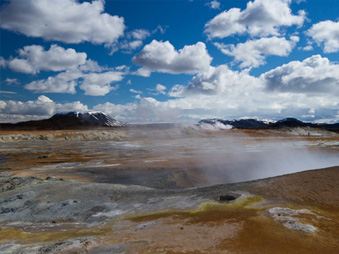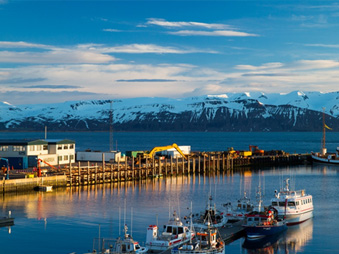-

- Mývatn
Mývatn is a shallow eutrophic lake situated in an area of active volcanism in the north of Iceland, not far from Krafla volcano. The lake and its surrounding wetlands have an exceptionally rich fauna of waterbirds, especially ducks. The lake was created by a large basaltic lava eruption 2300 years ago, and the surrounding landscape is dominated by volcanic landforms, including lava pillars and rootless vents (pseudocraters). The effluent river Laxá is known for its rich fishing for Brown Trout and Atlantic Salmon.
The name Mývatn is sometimes used not only for the lake but the whole surrounding inhabited area. The River Laxá, Lake Mývatn and the surrounding wetlands are protected as a nature reserve (the Mývatn-Laxá Nature Conservation Area).
Since the year 2000, a marathon around the lake takes place in summer.
-

- Akureyri
Akureyri is a town in northern Iceland. It is Iceland's second largest urban area (after the Greater Reykjavík area).
Nicknamed the Capital of North Iceland, Akureyri is an important port and fishing centre, with a population of 17,754. The area where Akureyri is located was settled in the 9th century but did not receive a municipal charter until 1786. The town was the site of Allied units during World War II. Further growth occurred after the war as the Icelandic population increasingly moved to urban areas.
The area has a relatively warm climate due to geographical factors, and the town's ice-free harbour has played a significant role in its history.
-

- Húsavík
Húsavík is a town in Norðurþing municipality on the north coast of Iceland on the shores of Skjálfandi bay with 2,237 inhabitants. The most famous landmark of the town is the wooden church Húsavíkurkirkja, built in 1907.
Húsavík has become a centre of whale watching in Iceland due to whales of different species that frequently enter the bay. The Húsavík Whale Museum is located in the downtown by the harbour.








